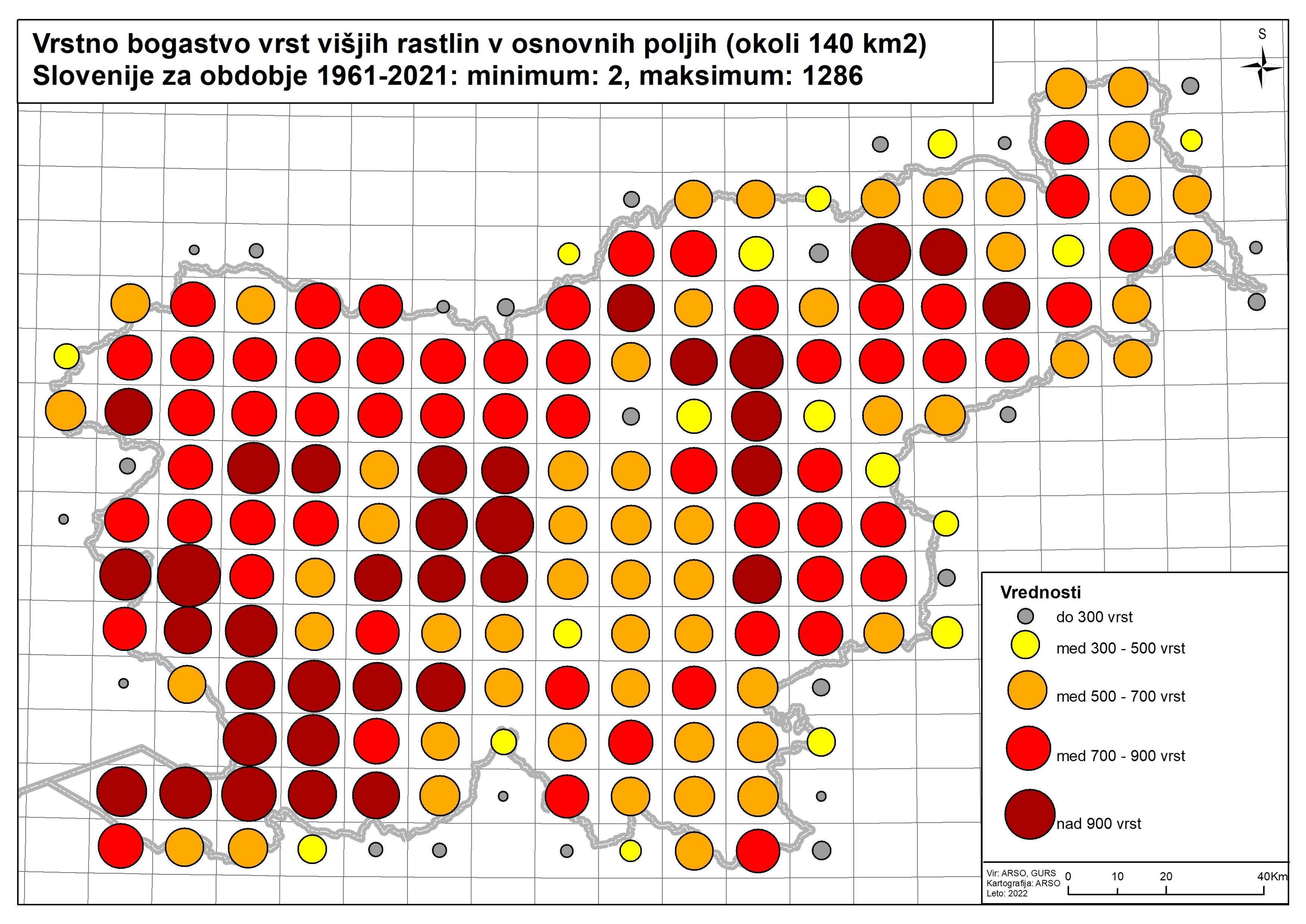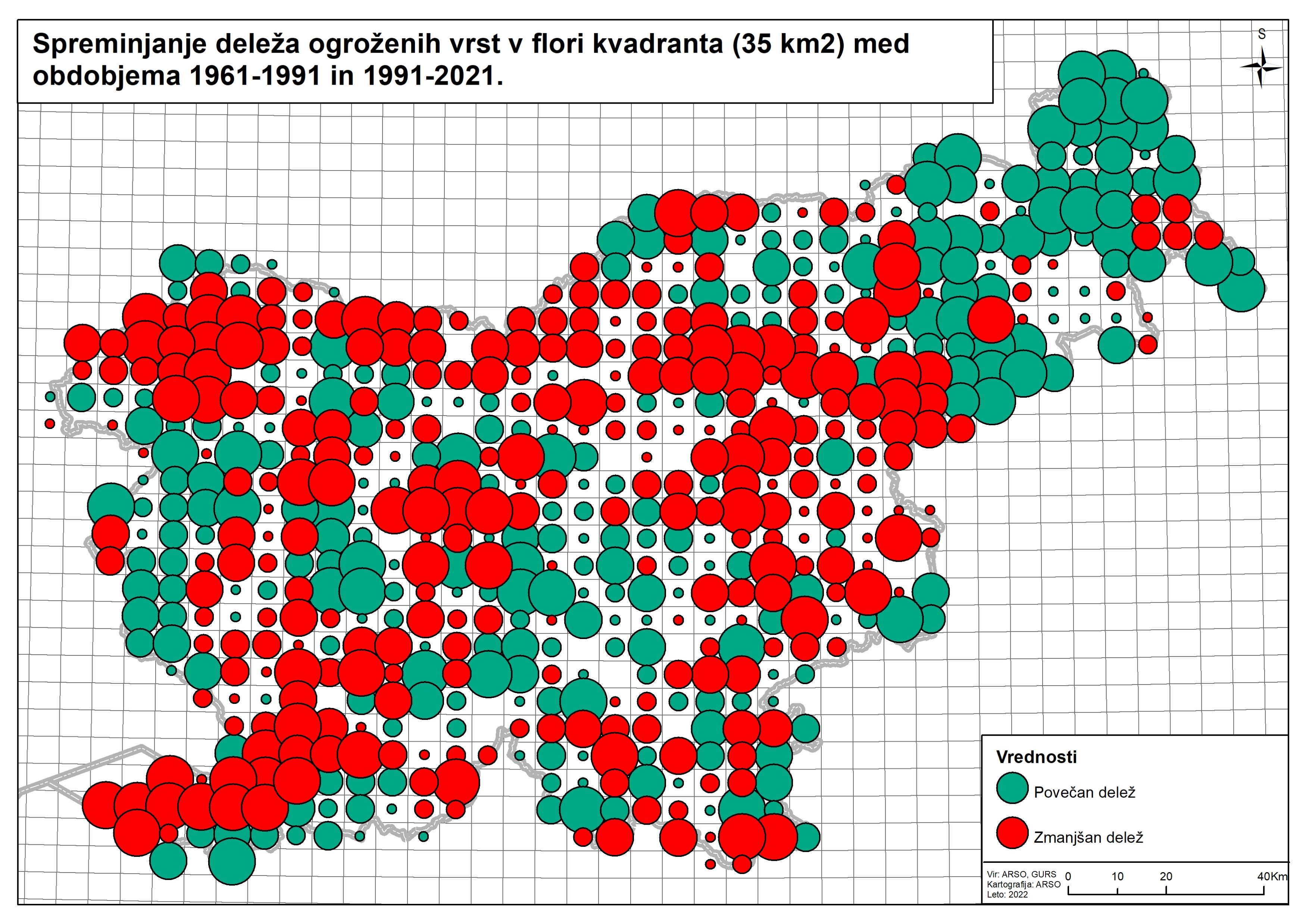[NB05] Plants – species richness and endangered species

Key message

Species diversity in Slovenia is stil considerably well preserved, distinctly higher in western part of the country. Without systematic monitoring on permanent plots it is impossible to recognize short term trends, but in some regions negative trends are result of landuse changes and impact of alien invasive species.
The diversity of plant species in western Slovenia (most of the Alpine region, Slovenian submediterranean region with Kras and part of Istria) with 800 or more taxa within approximately 140 km2 (basic field of four quadrants) is considerably higher than in the central and eastern parts of Slovenia.
The trend of reduction of number of endangered plant species is noticeable in Slovenian Istria (predominantly coastal and some Mediterranean species), in the areas of Celje and Krško plains and in the wider area of Slovenian Alps. An apparent improvement of conditions is dispersed throughout Slovenia with several indistinct concentrations in the upper Soča Basin, and particularly in Pomurje region.
Definition
The Richness of plant species is mostly related to diversity of habitat types, which, in turn, depends on various factors ranging from natural geographic (altitude range, solar exposure, geological structure) to florogenesis-related and pure anthropogenic (intensity of impacts on nature, urbanisation, extensiveness of farming, etc.).
The indicator shows the species richness of plant species for different periods, based on the available data. All the data for the last 60 years were taken into account for the estimate of species richness of higher plants, i.e. the period 1961–2021, while comparisons were made for the periods 1961–1991 and 1991–2021 (together approximately 430,000 pieces of data).
Raw input data contained around 1,000,000 data points on the presence of species of vascular flora within the territory of Slovenia. Among the available data, only that with sufficient topographic accuracy was selected so it could be undisputedly placed into the grid of 35 km2 quadrants.
Charts
Podatkovna zbirka: Flora Slovenije, 2022
Podatkovna zbirka: Flora Slovenije, 2022
Goals
- conservation of autochtonous species
- monitoring of populations of species of EU importance that enables recognition of conservation status of species and habitat types
- increase of knowledge on biodiversity and its importance for society
- update of red data lists
- stagnation or improvement of habitat types and species status until 2030
- improvement of population status of threatened species
Comment
Considering the fact that plants are primary producers and thus major biomass contributors, creating living environments for the majority of other organisms, they are simply indispensible for monitoring the state of the environment. However, the level of knowledge about certain plant groups and, consequently, the density of data on their occurrence, is very low in Slovenia; as a consequence, despite their known indicator values (e.g. algae and lichens), they cannot be used as indicators that would enable a good overview of the state of the environment for the entire country. On the other hand, certain groups are well studied in addition to being good indicator groups (e.g. wild orchids), but there is no systematic or regular sampling for them over a wider area. Relatively slow trends of changes represent a problem as well. All of the aforementioned information should be taken into account in the interpretation, as both figures are presented in order to provide general information and to allow comparison between them.
Species richness of plants: on approximately 140 km2, which is the size of 4 quadrants, which, together, form a basic field, there are generally 800 or more taxa in western Slovenia (most of the Alps and the Slovenian sub-Mediterranean region that includes the Kras Plateau and part of the Istria Peninsula, average number around 730), which is considerably more than in central and eastern Slovenia (average number around 640). Certain areas with notably higher sampling intensity (e.g. Ljubljana and its vicinity) deviate from the overall picture. Only a small portion of some basic fields along the border fall within Slovenia, which results in low numbers despite high biodiversity. The general impression confirms the long-known fact that plant diversity is closely related to the diversity of habitat types, which, in turn, depends on various factors ranging from natural geographic (altitude range, solar exposure, geological structure) to florogenesis-related and pure anthropogenic (intensity of impacts on nature, urbanisation, extensiveness of farming, etc.).
Changes in the share of threatened plant species within a quadrant: green squares indicate quadrants in which the share of threatened plant species in the last decade was higher than a decade earlier, while black squares indicate quadrants in which the share of threatened species was reduced or certain threatened species disappeared. The size of circles is proportional with the difference between the shares in the given periods, which means that squares with the same share of threatened species in both periods look like those species are missing, because the trend is 0 (zero).
Any other or further interpretation is highly delicate, as it is obvious that certain border quadrants derogate the most (in a positive or negative direction). In those quadrants, the result may be an artefact or a consequence of randomly biased sampling. Nevertheless, it is clearly evident that the trend of extinction of threatened species is noticeable in Slovenian Istria, in wider area of Celje plain to the W Haloze, in Krško plain (Prilipe, Jovsi, Dobrava) and, as it seems, in the whole Slovenian Alps. On the other hand, quadrants with a seemingly improved state are more dispersed all over Slovenia with certain indistinct concentrations in upper Posočje, in Pohorje area and particularly in Pomurje.










